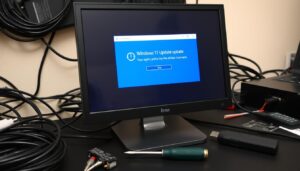Tracert commands are key for network admins and IT pros. They help find and fix network problems. With today’s complex networks, finding and fixing issues is crucial. Tracert commands help by showing where data goes and where it might get stuck.
Tracert commands give deep insights into your network. In this article, we’ll dive into tracert commands. We’ll see what they do and how to use them to improve your network. They’re a must-have for anyone working with networks.
Important Takeaways
- Tracert commands help identify and troubleshoot network issues.
- Network tracing tools are essential for assessing internet connections.
- Tracert commands can spot network bottlenecks or failures.
- Using tracert commands can offer insightful information on network operation.
- Tracert commands are valuable assets for network diagnostics and optimization.
- The path that data takes to reach its destination can be tracked using tracert instructions.
- Network performance can be improved and network problems can be troubleshooted with tracert commands.
Understanding Tracert Commands and Their Purpose
Tracert commands are key for network troubleshooting. They help IT pros see how data travels to its destination. Using tools like tracert, admins can spot problems and make networks run better. Knowing how to use tracert is crucial for network health.
Some main benefits of tracert include:
- Improved network reliability
- Reduced downtime
- Enhanced overall performance
Tools like tracert are vital for a smooth network. Learning to use them boosts IT skills.
Exploring tracert commands will show you how to trace network routes. This knowledge helps you find and fix network problems.
What is a Tracert Command?
A tracert command is a tool for tracing data paths. It’s key for network health and performance.
How Network Route Tracing Works
Route tracing sends data packets and tracks them. This helps find network bottlenecks and improve performance.
Benefits of Using Tracert for Network Diagnostics
Tracert offers many benefits for network checks. It boosts reliability, cuts downtime, and improves performance. With tracert, you can manage networks better and keep them running smoothly.
| Network Diagnostic Tool | Benefits |
|---|---|
| Tracert | Improved network reliability, reduced downtime, enhanced overall performance |
Essential Syntax and Basic Usage
To use trace route commands for internet connectivity testing, knowing the basics is key. The Tracert command traces data paths to find network problems. It helps see where issues might be.
The Tracert command is simple to use. Just type in tracert at the command prompt in addition to the hostname or IP address of the website. For example, tracert www.example.com checks if a website is reachable through the internet. It shows the path your data takes, including each router’s IP address.
Some important options for Tracert include:
- -d: stops Tracert from showing hostnames
- -h: sets the max number of hops to search
- -j: makes a loose source route
Learning Tracert’s syntax and use helps with internet connectivity testing. It’s useful for both network admins and home users. Knowing how to use Tracert can improve your network’s performance.

With practice, you’ll get better at using Tracert for internet connectivity tests. Always use the right syntax and options for the best results.
| Command | Description |
|---|---|
| tracert | traces the path to a destination |
| tracert -d | prevents IP address resolution |
| tracert -h | specifies the maximum number of hops |
Common Network Issues Solved with Tracert
Tracert is a key tool for network performance analysis. It helps IT experts find and fix common network problems. With Tracert, they can spot issues fast, cut downtime, and boost network speed. It’s great for troubleshooting network issues quickly and well.
Some common network issues that Tracert can solve include:
- Identifying network bottlenecks and areas of congestion
- Locating connection failures and dropped packets
- Measuring network response times and latency
- Detecting routing problems and incorrect configurations
Using Tracert for network performance analysis and troubleshooting network issues keeps networks running well. This leads to better productivity, lower costs, and more reliable networks.
Regular Tracert use stops big network problems before they start. It lets IT pros stay ahead in fixing network issues. Tracert gives deep insights into network performance, making it crucial for any IT pro aiming for better network reliability and speed.
| Network Issue | Tracert Solution |
|---|---|
| Network Bottlenecks | Identify areas of congestion and optimize traffic flow |
| Connection Failures | Locate dropped packets and configure connections for reliability |
| Network Response Times | Measure latency and optimize network configuration for improved performance |
Advanced Tracert Techniques for Network Professionals
For network professionals, learning advanced Tracert techniques is key. Using network tracing tools and command line tools helps improve network troubleshooting. This means customizing Tracert commands, combining it with other tools, and setting up automated monitoring.
Some important advanced methods include:
- Using parameters to set the maximum number of hops or the timeout value
- Combining Tracert with tools like ping and telnet for a full network view
- Setting up automated monitoring to quickly spot and fix network issues
These advanced methods help network pros boost performance, cut downtime, and make networks more efficient. For example, using command line tools to run Tracert automatically can find network problems. Combining Tracert with other tools gives a clearer picture of network issues.

Mastering advanced Tracert techniques needs a strong grasp of network tracing tools and command line tools. It also requires applying this knowledge in real situations. This way, network pros can make their diagnostics and troubleshooting better, keeping networks running smoothly and efficiently.
Conclusion: Maximizing Network Efficiency with Tracert
Tracert commands are key for network pros to boost network performance analysis and fix connectivity problems. They help IT teams find issues, track down connection failures, and measure how fast data moves. This makes networks run smoother.
To get the most out of tracert, it’s important to learn and keep learning. Knowing how to use tracert well helps teams spot and fix problems fast. By combining tracert with other tools, they can watch over networks closely and fix issues before they cause trouble.
Remember, tracert commands are your friends in keeping networks strong and fast. Use what you’ve learned here to keep improving. This will help your organization stay ahead in the digital world.
FAQ
What is a Tracert command?
A Tracert command is a tool for checking network paths. It shows the route data takes to reach its destination. This helps find network problems.
How does Tracert work?
With progressively higher Time-to-Live (TTL) values, Tracert delivers packets to their destination. Each router decreases the TTL and sends a response back. This reveals the path the packets took.
What are the benefits of using Tracert for network diagnostics?
Tracert has many benefits. It helps find network bottlenecks and slow connections. It also locates connection failures and measures response times. It detects routing problems and troubleshoots network issues.
What is the basic syntax for a Tracert command?
The tracert [hostname or IP address] command is the fundamental Tracert command. This command initiates a trace route that displays the path to the target.
How may network bottlenecks be found using Tracert?
Tracert analyzes packet loss and response times to find bottlenecks. Significant delays or loss at a hop may show a bottleneck.
How can Tracert be used to detect routing problems?
Tracert detects routing problems by finding unexpected hops. Unusual paths may indicate a routing issue.
What are some advanced Tracert techniques for network professionals?
Advanced Tracert techniques include using parameters and switches. Network professionals also integrate Tracert with other tools. They use automated monitoring solutions with Tracert data.







Your point of view caught my eye and was very interesting. Thanks. I have a question for you.
Can you be more specific about the content of your article? After reading it, I still have some doubts. Hope you can help me.